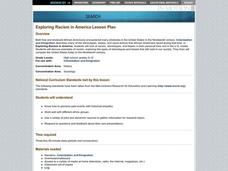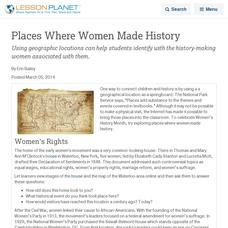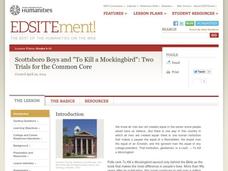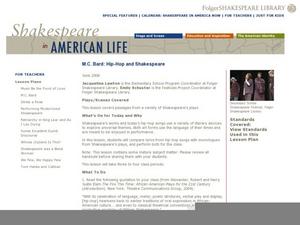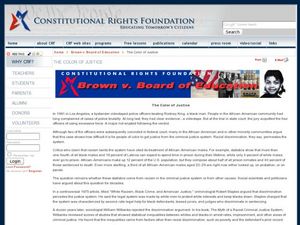Curated OER
Getting the Hang of Philanthropy
Learners identify examples of philanthropy in the family and community. They describe the economic impact of philanthropy on the family and community. They compare volunteer activities people do today with activities done in an earlier...
Curated OER
Exploring Racism in America
Young scholars compare racism today to racism that existed during the nineteenth century. As a field research project, students individually keep track of examples of racism, biases, and stereotypes illustrated throughout the US media...
Curated OER
Reconstruction and the 1868 South Carolina Constitution
Students, through lecture and group discussion, explore the American Civil War Reconstruction and how it affected the development of the 1868 Constitution of South Carolina. They discuss its impact on South Carolina even today.
Curated OER
Songs of Unrest - Lesson 4
Students identify popular songs from 1968 and make connections with the year's current events. They pretend that they are producing a new CD. The CD includes four songs that comment on today's social issues. They write the liner notes.
Curated OER
Underground Travelers
Students are introduced to new vocabulary associated with the Underground Railroad. Using primary sources, they evaluate the railroad's impact on society in the past and today. They also make a judgment about the morality of the railroad...
Curated OER
Roll Of Thunder, Hear My Cry
Young scholars read the novel "Roll of Thunder, Hear My Cry". Using the text, they gather information on how and why the Civil Rights Movement began. They use excerpts from Martin Luther King Jr's speeches to discuss the issue of...
Curated OER
Lincoln-Douglas Debates of 1858
Students examine the transcripts of the 1858 Lincoln-Douglas debates and create a platform for each candidate in the 1858 Senate race. They utilize the candidates' arguments to explore the historical and political impact.
Curated OER
Places Where Women Made History
Using places can help students identify with the history-making women associated with them.
National Endowment for the Humanities
Scottsboro Boys and "To Kill a Mockingbird": Two Trials for the Common Core
Here's a must-have resource for anyone reading To Kill A Mockingbird or using Harper Lee's award-winning novel in a classroom. The packet contains Miss Hollace Ransdall's first-hand, factual account of the trials of the Scottsboro Boys,...
Curated OER
The Roaring Twenties
In this Roaring Twenties Era worksheet, students review a chapter as they identify 5 vocabulary terms or individuals quotes, eliminate 4 false statements, and identify 2 themes from the era of great change in the United States.
Curated OER
M.C. Bard: Hip-Hop and Shakespeare
What is poetry? Does hip-hop qualify as poetry? Do Shakespeare's monologues qualify as poetry? Class members grapple with these questions as they examine the poetic elements and themes presented in different texts. Groups of four study...
Smithsonian Institution
Solomon G. Brown: Letter Writing
Personal correspondence in the form of letters is not as common as it once was. This resource presents an opportunity for you to introduce your class to letter writing and cover topics in social studies. Learners read a letter written in...
Curriculum Corner
February Bell Ringers
Use a set of 30 writing bell ringers to get through the month of February. Writers tap into and write about how February makes them feel, what it smells like, and all types of celebrations that occur during the month.
National First Ladies' Library
Trouble in Little Rock: The Desegregation of Central High School
Middle schoolers study one aspect of the Civil Rights Movement in the United States; the battle over desegregating the public schools. They study the desegregation of Central High School in Little Rock, Arkansas by producing a newspaper,...
Alabama Department of Archives and History
Alabama Farm Life in the Great Depression
The Great Depression not only impacted city folk and factory workers, it also had a profound effect on farmers. Young historians examine primary source materials that document the struggles of Alabama farmers during this time and...
Alabama Department of Archives and History
Alabama's 1901 Constitution: What Was at Stake?
Who should be able to vote? As part of a study of the 1901 Alabama Constitution, class members examine primary source document that reveal the reasons the authors gave to support their positions on this question and their assumptions in...
Learning to Give
What Are Your Thoughts?
The varying responses of the characters in Mildred Taylor's Roll of Thunder, Hear My Cry to the discrimination they experience or perpetrate provides readers with an opportunity to not only examine the feelings of the characters but...
Curated OER
Questions of Courage
Examine discrimination. In this character education lesson, learners read two biographies, Vivien Naki and Hamilton Naki then analyze their personal discrimination experiences. They complete a Venn diagram to compare and...
K12 Reader
Civil Rights Biography: Dr. Martin Luther King, Jr.
Introduce your class to Dr. Martin Luther King, Jr. and his many accomplishments through a one-page biography. Class members read the text and respond to three questions included at the end.
Curated OER
Claudette Colvin: Twice Toward Justice
Use the historical account of Claudette Colvin to study civil rights and connect past injustices to modern issues. As learners read, they examine chapter titles, record quotes, and participate in discussion. Next, they research...
PBS
March on Washington: A Time for Change
Young historians conclude their study of the events that lead up to and the planning for the March on Washington. After examining videos and primary source documents, they consider the civil rights objectives that still need to be...
University of Virginia
Illustrating Uncle Tom's Cabin
Historical illustrations reveal more than what they are meant to portray. After reading Harriet Beecher Stowe's Uncle Tom's Cabin, high schoolers view a series of illustrations, movie posters, photographs, and book covers that exemplify...
Reading Through History
The Fugitive Slave Act of 1850
Why was the Fugitive Slave Act of 1850 so important? The reading in the resource discusses how the act affected Southerners, Northerners, and the slaves themselves. Scholars complete the reading as a form of direct instruction while...
Curated OER
The Color of Justice
High schoolers analyze racism and justice. In this legal system discrimination lesson plan, students listen to their instructor lecture on disparities in the legal system. High schoolers respond to discussion...



